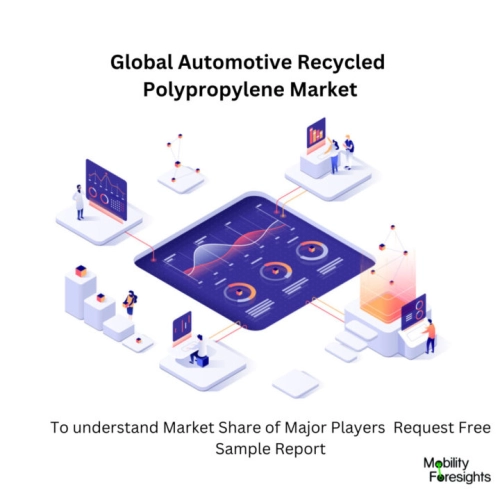
- Get in Touch with Us

Last Updated: Apr 25, 2025 | Study Period: 2023-2030
Automobile recycled polypropylene is a form of polypropylene (PP) plastic material that is recycled for use in the automobile industry and obtained from post-consumer or post-industrial sources. Due to its light weight, durability, and chemical resistance, polypropylene is a flexible thermoplastic polymer that is frequently utilized in a variety of automotive applications.
The process of recycling polypropylene entails gathering old or discarded PP items, such as automobile parts, packaging, and other plastic products, processing them to remove impurities, sorting them by color or grade, and then turning them into reusable polypropylene pellets or flakes. Then, new automobile components or parts may be produced using these recycled materials as the raw material.

The Automotive recycled polypropylene accounted for $XX Billion in 2022 and is anticipated to reach $XX Billion by 2030, registering a CAGR of XX% from 2023 to 2030.
One of the top producers in the global market for recycled polypropylene used in the automotive industry, ExxonMobil Corporation, provides a variety of goods to satisfy the expanding need for eco-friendly materials in the sector.
ExxonMobil has created a number of recycled polypropylene materials expressly for automotive applications as part of its strong commitment to innovation and environmental responsibility.
ExxonMobil Achieve Advanced PP, one of the company's well-known products, has a number of alternatives for recycled material. This product line strives to offer high-performance materials to automobile makers while minimizing environmental effect.
ExxonMobil Achieve Advanced PP strikes a mix between processability, mechanical attributes, and sustainability, making it appropriate for a range of automotive applications including interior trim, exterior trim, and engine-related components.
ExxonMobil Corporation also provides performance polyolefins called ExxonMobil Exxtral that can include post-industrial recycled material. These materials are designed to suit the sustainability objectives of automobile manufacturers while also providing great performance and processability.
They are perfect for automotive applications that demand dependability and longevity because to their outstanding impact resistance, dimensional stability, and resistance to chemicals and UV radiation.
ExxonMobil Corporation frequently participates in joint research and development initiatives with automakers and suppliers in addition to their product offerings. The performance and sustainability of recycled polypropylene materials in the automobile industry are improved thanks to this collaboration's assistance in identifying new possibilities and creating creative solutions.
| Sl no | Topic |
| 1 | Market Segmentation |
| 2 | Scope of the report |
| 3 | Abbreviations |
| 4 | Research Methodology |
| 5 | Executive Summary |
| 6 | Introduction |
| 7 | Insights from Industry stakeholders |
| 8 | Cost breakdown of Product by sub-components and average profit margin |
| 9 | Disruptive innovation in the Industry |
| 10 | Technology trends in the Industry |
| 11 | Consumer trends in the industry |
| 12 | Recent Production Milestones |
| 13 | Component Manufacturing in US, EU and China |
| 14 | COVID-19 impact on overall market |
| 15 | COVID-19 impact on Production of components |
| 16 | COVID-19 impact on Point of sale |
| 17 | Market Segmentation, Dynamics and Forecast by Geography, 2023-2030 |
| 18 | Market Segmentation, Dynamics and Forecast by Product Type, 2023-2030 |
| 19 | Market Segmentation, Dynamics and Forecast by Application, 2023-2030 |
| 20 | Market Segmentation, Dynamics and Forecast by End use, 2023-2030 |
| 21 | Product installation rate by OEM, 2023 |
| 22 | Incline/Decline in Average B-2-B selling price in past 5 years |
| 23 | Competition from substitute products |
| 24 | Gross margin and average profitability of suppliers |
| 25 | New product development in past 12 months |
| 26 | M&A in past 12 months |
| 27 | Growth strategy of leading players |
| 28 | Market share of vendors, 2023 |
| 29 | Company Profiles |
| 30 | Unmet needs and opportunity for new suppliers |
| 31 | Conclusion |
| 32 | Appendix |